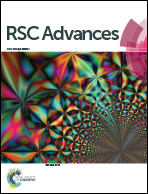Chemical and biological study of aplysiatoxin derivatives showing inhibition of potassium channel Kv1.5†
Abstract
Three new aplysiatoxins, neo-debromoaplysiatoxin D (1), oscillatoxin E (2) and oscillatoxin F (3), accompanied by four known analogues (4–7), were identified from the marine cyanobacterium Lyngbya sp. Structural frames differ amongst these metabolites, and therefore we classified compounds 1 and 4–6 as aplysiatoxins as they possess 6/12/6 and 6/10/6 tricyclic ring systems featuring a macrolactone ring, and compounds 2, 3 and 7 as oscillatoxins that feature a hexane-tetrahydropyran in a spirobicyclic system. Bioactivity experiments showed that compounds 1 and 4–6 presented significant expression of phosphor-PKCδ whereas compounds 2, 5 and 7 showed the most potent blocking activity against potassium channel Kv1.5 with IC50 values of 0.79 ± 0.032 μM, 1.28 ± 0.080 μM and 1.47 ± 0.138 μM, respectively. Molecular docking analysis supplementing the binding interaction of oscillatoxin E (2) and oscillatoxin F (3) with Kv1.5 showed oscillatoxin E (2) with a strong binding affinity of −37.645 kcal mol−1 and oscillatoxin F (3) with a weaker affinity of −32.217 kcal mol−1, further supporting the experimental data.



 Please wait while we load your content...
Please wait while we load your content...